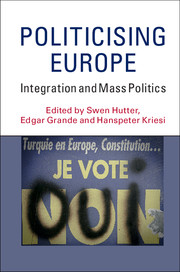Book contents
- Frontmatter
- Contents
- List of figures
- List of tables
- List of contributors
- Preface and acknowledgements
- Part I Theory and methods
- Part II Mapping the politicisation of European integration
- Part III Driving forces and consequences of politicisation
- Part IV Conclusions
- Methodological Appendix: measuring politicisation, benchmarks and data
- Bibliography
- Index
Methodological Appendix: measuring politicisation, benchmarks and data
Published online by Cambridge University Press: 05 March 2016
- Frontmatter
- Contents
- List of figures
- List of tables
- List of contributors
- Preface and acknowledgements
- Part I Theory and methods
- Part II Mapping the politicisation of European integration
- Part III Driving forces and consequences of politicisation
- Part IV Conclusions
- Methodological Appendix: measuring politicisation, benchmarks and data
- Bibliography
- Index
Summary
This Methodological Appendix serves four purposes. First, we explain how we operationalise the three dimensions of politicisation. Second, we show how we combine the indicators of the three dimensions in our politicisation index. Third, we discuss the construction of the empirical benchmarks which allow us to compare the politicisation of European integration with other political issues. Finally, we present tables with the values of all the indicators and the index for each integration step and election campaign (see Tables A.2 and A.3). The tables allow the interested reader to have a look at detailed information – because we sometimes needed to restrict our discussion in the empirical chapters to the index value only. In addition, the tables may serve as a reference for researchers interested in extending our study in time and space.
Measuring salience, actor expansion and polarisation
How did we measure the three dimensions of politicisation, i.e., salience, actor expansion and polarisation? While protest events by definition integrate the three dimensions, we had to find indicators for each of them in public debates on integration steps and election campaigns. For clarity and simplification, we rely on one indicator for each dimension and we operationalise them in a similar way for the two ‘windows of observation’ in order to secure comparability. The remaining differences – especially as regards the salience measure – are due to the different sampling and coding strategies for the two arenas (see Chapter 2).
Salience
In the case of election campaigns, we rely on a relative indicator to measure the salience of European integration. The indicator refers to the share of core sentences related to European integration as a percentage of all core sentences related to any political issue. We take into account both types of core sentences, i.e., actor–actor and actor–issue sentences. Note that in the context of this project we only coded actor–actor and actor–issues sentences with a thematic reference to European integration. We rely on data previously collected by Kriesi et al. (2008, 2012) to estimate the overall number of core sentences on all issues in a campaign (for details on the data, see ‘Constructing benchmarks’). We opted for the relative measure because the total numbers of coded sentences related to European integration give a very similar picture when looking at trends over time, but they are not well suited for comparative research.
- Type
- Chapter
- Information
- Politicising EuropeIntegration and Mass Politics, pp. 301 - 313Publisher: Cambridge University PressPrint publication year: 2016
- 1
- Cited by

